|
A Big Life In
A Few Words
Herbert Leslie Overend (he was always
called Leslie) was born in a cottage off Victoria Road,
Eccleshill, Bradford, on February 4, 1905 and was educated
at Hanson School and Woodhouse Grove, in the city.
Encouraged by his father, John William Overend, a teacher
and academic, he took an early interest in all things
technical, including photography.
Leslie took his first photograph in 1911, when still
at primary school. His father gave him a Klito box camera,
armed with a magazine of glass plates, and invited him
to take some pictures during a visit to Appleby, in
what was then called Westmorland.
The fact that the subject was merely the weir below
Appleby Castle, is of little significance. Remarkably,
unlike much of Leslie’s later work, one of the
battered plates still exists.
Many years later, Leslie told me the moment that he
took that very first picture he was
bitten by the photography bug. There was nothing else
he wanted to do, except take pictures.
From that day, he pursued his dream, the then extremely
unlikely quest of becoming a professional photographer.
By the time his working life ended, a remarkable 72
years later, in 1983, Leslie’s career had seen
him travel the length and breadth of England. He had
worked for myriad publications - from national newspapers
to tiny magazines – often toiling seven days a
week, and rarely taking a holiday.
Leslie’s professional career was kick-started
on November 11, 1918 – Armistice Day. The end
of the Great War meant the world had suddenly changed,
and Leslie’s was about to change as well.
Then, although aged just 13, he was quite familiar with
the latest photography techniques and
capabilities. He was tasked to climb to the top of Bradford
Town Hall to take a picture of the vast crowd of people
celebrating the end of the war hundreds of feet below
him. His only advice: “Don’t drop t’bloody
camera, and if you fall off, there’ll be no compensation.”
Leslie’s picture was published in the then Bradford
Daily Argus. It was a remarkable, iconic image. And
Leslie was invited to join the Argus staff just a month
later.
The following year, he joined the local opposition,
the Bradford Daily Telegraph, for the princely sum of
2s6d (12.5p) a week, only to rejoin the Argus soon after
as a trainee reporter/photographer. By then the newspaper
had been taken over by a London company and had become
known as the Yorkshire Evening Argus.
In 1926, Leslie and his father set up the Overend Press
Agency from their home in Eccleshill, later
moving to offices in nearby Greengates.
With Leslie as the roving photographer (during which
time he became a pioneer of aerial photography) the
company began supplying pictures to a wide variety of
publications all over Britain.
From small beginnings, the Overend Press Agency became
one of the country’s biggest sporting picture
agencies.
It was at this time that Leslie also started working
for local newspapers - including the Morley Observer
- which were only just beginning to use photographs.
At the end of the Second World War Leslie became more
involved with the Morley Observer, as well as other
newspapers in the West Riding, who were beginning to
use more and more pictures.
He also pursued his passion for the railways, taking
hundreds of pictures of steam engines up and down the
country. Leslie’s fame spread as many of the pictures
were featured on the covers of railway magazines. Many
of his iconic pictures are now owned by the National
Railway Museum at York.
Leslie always retained his freelance status, being paid
a fee for every picture published, and making additional
money from print sales.
On Sunday, November 20, 1955, Leslie - then aged 50
- married Doris Kathleen Morse at Esholt Parish Church,
Bradford. They were the first couple to hold their wedding
reception at the newly-converted Alexandra Hotel, which
had been the Empire Cinema. Leslie’s best man
was his long-time friend Phil Ridler, manager of the
New Victoria Theatre in the city.
The happy couple first met when Doris, originally from
Sunderland, managed the Royal Café in Bradford.
She later took ownership of the Rendezvous Café
in Town Hall Buildings, Morley.
Leslie and Doris initially lived together in the flat
above the Rendezvous Café.
Leslie sold his parents’ home in Chevin View,
Eccleshill (his mother had died in 1940, his father
in 1950), then, in 1958, he and Doris bought “Dinky
Dyson’s” chemist’s shop in Queen Street,
Morley, and set it up as a newsagents. Doris managed
the shop, while Leslie continued his press photography.
The couple’s plans to move to the Scilly Isles
and open a restaurant were dashed when Doris fell ill.
She died at Christmas, 1960.
In August 1961, Leslie had travelled back to the Scilly
Isles to scatter Doris’s ashes, when a waiter
approached him to tell him that he had just heard on
the radio that “the centre of Morley was on fire”.
Although not quite true, it was serious
enough – sparks from a fire at the ready-for-demolition
Albert Mills, in Princess Street (see picture, right),
had been blown on to the Town Hall’s wooden dome
by strong winds.
The resulting fire destroyed the dome and pinnacle.
Water used to fight the blaze caused extensive damage
to the building - some of floors had to be cut to allow
the thousands of gallons of water to drain away.
On hearing the news, Leslie immediately got on the phone
to Morley, but he couldn’t get through. Eventually,
he managed to reach an old friend, Tommy Marshall, who
used to do some work for him. Tommy told Leslie that
the girl he had left in charge of his newsagents had
taken a couple of rolls of films of the blaze and he
had driven over from Bradford to process them.
When Leslie returned to Morley he offered the pictures
to the Morley Observer, but they didn’t use them,
and used pictures taken by a local chemist – even
though he always felt “his” pictures were
far better.
Although the pictures weren’t published at that
time, they have been published many times since, and
illustrate brilliantly the drama the fire brought to
Morley that day.
Leslie sold his shop in 1962 and moved into an old house
in Leeds Road, Dewsbury. In 1965 the building was condemned
as being unfit for human habitation, compulsory purchased
and demolished.
Leslie moved into a council flat in Thornhill Lees,
Dewsbury.
In 1983, after a career of some 65 years, he was forced
to retire due to ill health.
Up to his death, on May 16, 1989, Leslie lived alone
with his memories and a mountain of negatives, which
he passed, in his will, to Stephen White.
|
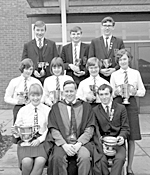
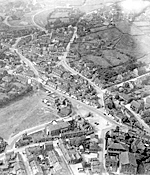
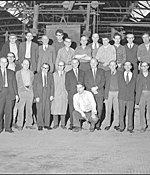
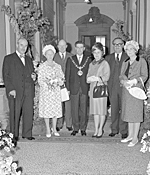
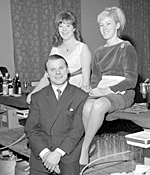
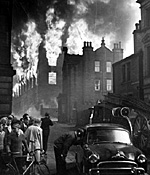
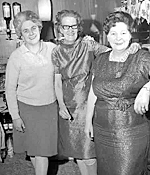
|